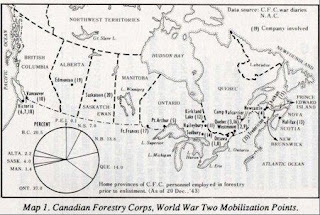World War 2 put tremendous stains on supplies of natural resources of all types, but on wood in particular. In addition to civilian requirements, the military needed timber for road and bridge building in support of the front lines, soldiers’ living quarters, rail lines, ships, coffins, gun stocks, crates to transport food, ammunition and equipment and countless other needs. Britain Canada Canada formed the Canadian Forestry Corps, recruiting from across the country and by 1942 deploying 7000 men in 30 Companies, mostly to the forests of Scotland
A Family Business
 |
| James Valentine Rogers with crew c.1905. |
Stanley was born in Stellarton , Nova Scotia
 |
| Portable steam sawmill of type similar to that used by Rogers crews. |
When his father died in 1909 Stanley Stanley
Being essentially just large steam-boiler engines, the portable sawmills were a constant fire hazard, as their boiler tanks grew hot and fuel fires spit sparks onto surrounding ground that was usually dry brush and wood debris. Stanley’s son Charles recalls how he and brother Prescott, when they were still too young to help with the actual logging and milling, would often be tasked with keeping watch over the mill site with fire-fighting equipment.
 |
| View of Mill from roof of Millstream house. |
About 1934 Stanley shifted from portable operations, acquiring one of eastern Canada’s oldest mill structures in Millstream, just south of Stellarton. It was here the family called home for the next ten years, interrupted by one year in nearby Hopewell
War
 |
|
(For material in the next sections I am heavily indebted to the research of Robert Briggs and in turn to his primary source, “The Sawdust Fusiliers: the Canadian Forestry Corps in the Scottish Highlands in World War Two” by William C. Wonders)
Emerson, Sheldon and Doug signed up early, in September 1939, and headed overseas in January 1940 with the 1st Field Co. Combat Engineers.
In May 1940, as the call went out for loggers and millmen to fill the Forestry Corps., Stanley, already a veteran of one world war, signed up again for service. Recruitment centres for the Corp were spread across the country, with No. 13 Company mobilizing in Halifax Valcartier , Quebec Scotland
 |
No. 13 Company, Canadian Forestry Corps, Canadian Active Service Force, Saint Michel Train Station, Quebec, October 1940
|

When training at Valcartier was complete, the company once again boarded a train and returned to Halifax to depart by troop ship for Scotland. They arrived June 30, 1941 at Firth of Clyde as part of a six ship convoy, disembarked July 2 at Gournock, caught a train to Brechin and from there went by truck to South Esk to establish their first camp. Most CFC personnel built barracks, roads, bridges and set up power plants from scratch. However No. 13 Company’s camp was already nearly completed by civilian contractors when they arrived. Thus while other companies often took up to 3 months to become operational, No. 13 took less than half that time, beginning timber operations August 14. [No. 13 didn’t stay in one place for the war’s duration as some other companies did. They moved November 8, 1943 to Orrin Bridge , Muir of Ord; July 15 1944 to Skibo, Spinningdale; and November 14, 1944 back to Orrin Bridge
Each company was divided into two sections, one cutting timber and bringing it out of the bush, the other sawing it into lumber at the mill. The 13th Co. had brought with them some of the most modern logging equipment then available in Canada
 |
| Nissen hut. |
The men in most camps erected Nissen huts for accommodation. These huts, developed by Peter Nissen of the Royal Engineers in WW1 based on a design he developed while studying mining engineering in Kingston , Ontario
 |
| Heavy CFC log truck. |
The heavy lumber lorries stained much of the local infrastructure. Road had to be graveled and some bridges reinforced. No 13 Company in particular had to significantly reinforce Garve Bridge
 |
| No. 13 Co. men with bridging material to repair |
In June 1940, the 1st Field Combat Engineers with Stanley ’s sons Emerson, Sheldon and Doug went to France Laval before they were ordered back as part of the broader evacuation of France. Back in Britain Sheldon and Emerson headed north to join their father with the 13thCFC. Doug stayed with his unit and eventually went with them to Sicily and Italy Rogers
 |
Co. 13 in
Emerson 4th row, far right?,
|
Highlights
Shortly after arriving 600 men (3 companies) of the Corps received a Royal Inspection by the King and Queen at Balmoral Castle on September 7, 1941, one of the highlights of the wartime experience for many of the CFC members.
 |
| His Majesty salutes the CFC. |
 |
| Queen Inspecting CFC at Balmoral Castle. |
 |
| Princesses Margaret and Elizabeth looking on. |
As for “low”-lights, there was a brawl in Montrose New Year’s Eve 1942 between some members of No. 13 and some Polish soldiers. A CFC member suffered knife wounds. And in the summer of 1943 one member of the 13th was murdered by another.
A Welcome Presence
The CFC made their presence known in the Scottish highlands. The men at times assisted in local agricultural harvesting, for example No. 13 Company helping with the flax harvest in Mearns in Sept 1941. They participated in local parades, staged Christmas parties for local children and helped with various wartime causes. Some attended religious services in the local churches or joined local lodges such as the Grand Lodge of Scotland in St. Andrew’s. It has also been recounted that it was common practice for forestry workers to pilfer some of the vehicle fuel to give to local taxis in exchange for rides into the village to bars and dances, and that on occasion scrap wood would mysteriously fall from lorries beside homes in need of fuel.
With 7000 men socializing with local communities, it was natural that some of the young local women would find husbands among the CFC foresters. One of those lucky ones was Elizabeth (Betty) Kay Wemyss. In August of 1943, at the age of 21, she married Emerson Rogers (then age 28) in her home town of St. Andrew
Winding Down and Moving On
 |
| Stanley on leave at Millstream Jan 1944 |
In preparation for the 1944 Normandy invasion, some companies moved to Southampton to construct rafts to be towed across the channel. Some went with the invasion force, supporting front line operations, and even helping to hold the front line against the December 1944 Ardennes counter-offensive by the Germans. The 13th Company was one of the ones that remained in Scotland
No. 13 Company ceased operations in Scotland Orrin Bridge
During their four and a half years in the highlands, No.13 Company produced 19.7 million FBM of sawn lumber, or about 5% (1/20) of the total production of the CFC, a commendable accomplishment considering they were one of thirty CFC companies! In addition there were many tens of thousands of poles, tons of pulpwood and other products.
Back in Canada
After the war Emerson returned to Canada with Betty, settling in Sydney Forks, Nova Scotia Stanley moved they rest of the family from Millstream to Oxford
Thursday Aug. 23, 1951 the Oxford Journal reported that “S.E. Rogers & Sons have sold their electric sawmill on
Lower Main Street to J.B. Alcorne ofBear River , N.S.
Lower Main Street to J.B. Alcorne of
After winding down his lumber operation Stanley
The reinforced bridges and road extensions left behind in Scotland Scotland
Steve Rogers is the son of Charles Rogers and grandson of Stanley E. Rogers
Sources
Births, Deaths and Marriages
Public Member Trees, Ancestry.com
Canadian Censuses of 1851, 1861, 1871, 1881, 1891, 1901, Library and Archives Canada
(Indexed on-line at Ancestry.ca and AutomatedGenealogy.com)
Economic Impact Analysis of Timber Management & Supply Changes on Nova Scotia’s Forest Industry, Report to the Department of Natural Resources, May 2011
Canadian Forestry Corps.
The Sawdust Fusiliers: the Canadian Forestry Corps in the Scottish Highlands in World War Two, William C. Wonders, Canadian Pulp and Paper Association
Canadian Forestry Corps., Bob Briggs, http://freepages.genealogy.rootsweb.ancestry.com/~jmitchell/cfc24.html
Canadian Forestry Corps in the local woods, Rambling On, swanscott.wordpress.com
James Valentine Rogers and Stanley E Rogers
Windham Hill is Home: A Rogers Genealogy, Alice Rogers Nieman, 1989, Halcraft Printers Inc., Halifax
Images
Portable Steam Powered Sawmill:
Photo by Ruth Tate, Historical Ouachita County
Rogers mill crews, Millstream, Rogers brothers in Europe, Stanley
Collection of Charles D. Rogers
All other images:
Canadian Forestry Corps., Bob Briggs, http://freepages.genealogy.rootsweb.ancestry.com/~jmitchell/cfc24.html
and in turn… The Sawdust Fusiliers: by William C. Wonders, Collections of Robert J. Briggs, Mitchell Bell, Major James Matthew Soy, Charles Frederick Neale, Marie Pemberton

















